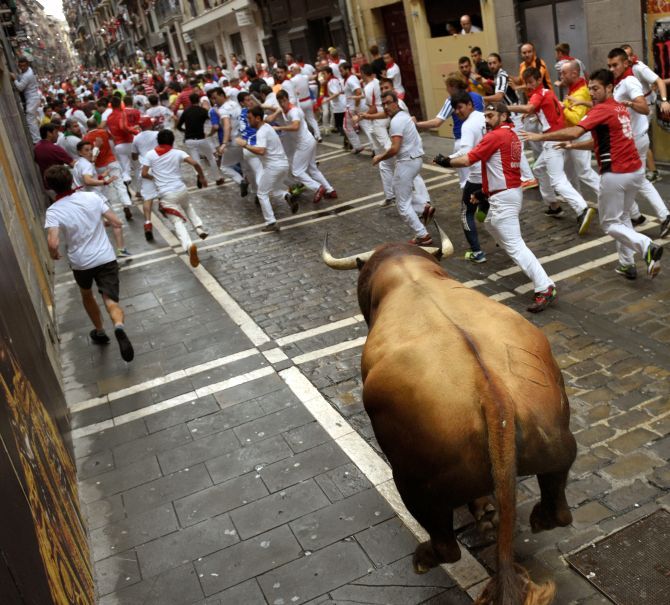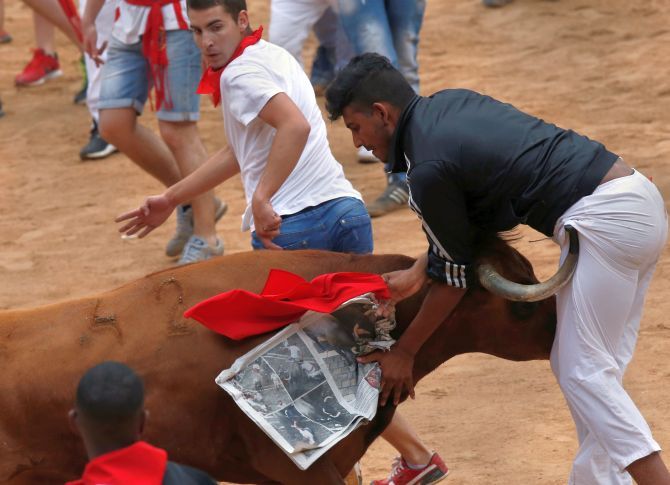 | « Back to article | Print this article |
“I can compare the hoof-beating approach of the bulls charging down La Estafeta to nothing but the towering winter swells of the open Atlantic. It is a spectacle that is dark, powerful, and imminent. The Spanish bull seems a creature only comparable to the blue whale, the elephant, and perhaps the lion. But it is the colour of a rippling and moving black, amongst a fleeing and drunken mob of white and red men, which is the most stunning and incomprehensible.”
-- Jaed Muncharoen Coffin
It’s that time of the year again when people gather in Pamplona, Spain to participate in the 427-year-old festival of San Fermín from July 7 to July 14 and has the encierro, or bull run, at its heart.
The festival, which many have described as the ‘ultimate adventure sport’, is held in honour of the patron saint of Spain’s northern Navarra region -- San Fermin.
And for trivia lovers, here’s something: The festival was made famous by the 1926 novel of US writer Ernest Hemmingway entitled The Sun Also Rises.
Here’s a look at wild scenes from the run!

The run with the bull starts each day at 8 am. Participants gather at the square and chant to an image of San Fermin and ask for his blessing before the run, which lasts for three to five minutes.

The run so far has been particularly dangerous, with the bulls plowing into the slower-moving crowds, knocking many runners down as they maneuvered through the narrow streets and wooden barricades.

The run stretches along for 875-yards-long -- about half a mile. A good individual run may cover just a tiny fraction of that small course, and last just 15 or 20 seconds, like a killer wave for surfers.

Mozos, as the adrenaline-hungry adventurers who run with the bulls are called, traditionally wear white pants and shirts, accessorized with a red bandana around the neck or waist. One legend says the look is meant to honor San Fermin, as the white symbolises sainthood and the red the fact that he was martyred. Others say the mozos are meant to be dressed like the butchers who originated the tradition.

To keep up with all of the inevitable injuries, 200 volunteers and medical professionals are on site to treat participants. They’re stationed at 16 posts along the route, one every 50 yards.

But despite medical assistance being provided, many people have been killed during the runs. Records have been kept since 1910 and show that over the years 15 people have been killed during the runs, the majority of them through gouging.

The race has simple rules: Outrun the bull and 'don't touch the bull'. Slapping at or grabbing at the bull, touching its horns, or tugging its tail, are not only insults to the local citizenry, and illegal, but also dangerous because it may distract the bull enough to come and find you

Along with the bulls, a few oxen are also released. These oxen serve the purpose of guiding the bulls to run in the correct direction towards the bullring.

According to reports, the festival emerged for its practical purpose. The bull run started because it served as a way to transport the bulls from Pamplona's corral to its bullfighting ring where public spectacles were to be held throughout the fighting season.

According to figures available, a whopping 16,448 people took part in last year’s running of the bulls’ corridas (the race itself).

The festival also brings ongoing criticism from animal rights activists. Each year anti-bullfighting protests are held on the eve of the event, decrying the closing ritual in which the bulls are fought and killed by a matador in the historic bullring.

A day before the festival begins, a party mood is prevalent in the town with people dousing each other with wine and singing and dancing in the streets.